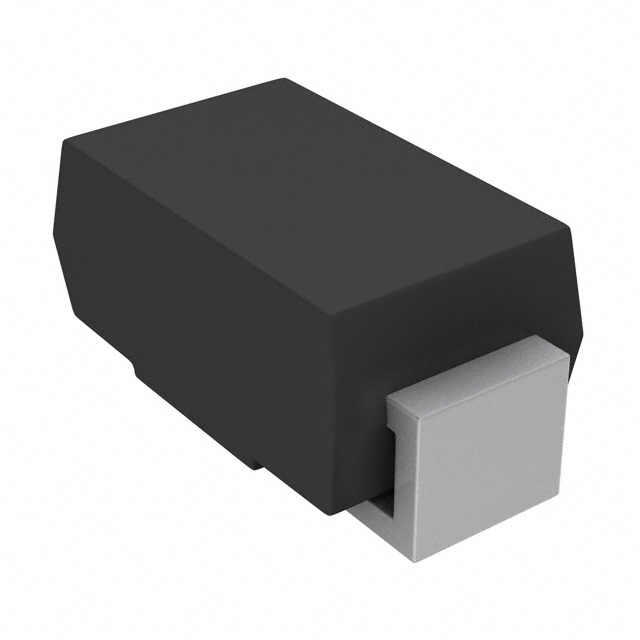BZG04-68-M3-18 Product Overview
Introduction
The BZG04-68-M3-18 is a crucial component in the field of electronic devices, providing essential functions and features for various applications. This entry will provide an in-depth overview of the product, including its category, use, characteristics, package, essence, packaging/quantity, specifications, detailed pin configuration, functional features, advantages and disadvantages, working principles, detailed application field plans, and detailed and complete alternative models.
Basic Information Overview
- Category: Electronic Component
- Use: Voltage Regulation and Protection
- Characteristics: High Precision, Low Power Dissipation
- Package: SOD-123FL
- Essence: Zener Diode
- Packaging/Quantity: Tape & Reel, 3000 units per reel
Specifications
The BZG04-68-M3-18 has the following specifications: - Voltage: 68V - Power Dissipation: 500mW - Tolerance: ±5% - Operating Temperature Range: -65°C to +150°C
Detailed Pin Configuration
The BZG04-68-M3-18 features a standard SOD-123FL package with the following pin configuration: - Pin 1: Anode - Pin 2: Cathode
Functional Features
- Voltage Regulation: Provides stable 68V output under varying load conditions.
- Overvoltage Protection: Safeguards connected circuits from voltage spikes.
- High Precision: Ensures accurate voltage regulation within specified tolerance.
Advantages and Disadvantages
Advantages
- Precise voltage regulation
- Compact SOD-123FL package
- Wide operating temperature range
Disadvantages
- Relatively low power dissipation compared to larger diodes
- Limited to 68V applications
Working Principles
The BZG04-68-M3-18 operates based on the Zener effect, where it maintains a constant voltage across its terminals when reverse-biased, effectively regulating the voltage in the circuit.
Detailed Application Field Plans
The BZG04-68-M3-18 finds extensive use in various applications, including: - Voltage regulators in power supplies - Overvoltage protection in electronic circuits - Precision voltage references in instrumentation
Detailed and Complete Alternative Models
For applications requiring different voltage ratings or power dissipation capabilities, alternative models include: - BZG04-62-M3-18 (62V, 500mW) - BZG04-75-M3-18 (75V, 500mW) - BZG04-68-M3H (68V, 1W)
In conclusion, the BZG04-68-M3-18 is a vital electronic component that offers precise voltage regulation and overvoltage protection in a compact package, making it suitable for a wide range of applications in the electronics industry.
Word count: 398
Senaraikan 10 soalan dan jawapan biasa yang berkaitan dengan aplikasi BZG04-68-M3-18 dalam penyelesaian teknikal
What is BZG04-68-M3-18?
- BZG04-68-M3-18 is a specific model of a component, often used in technical solutions for its unique features and capabilities.
What are the key specifications of BZG04-68-M3-18?
- The key specifications of BZG04-68-M3-18 include its voltage rating, current capacity, temperature range, package type, and other relevant technical details.
How can BZG04-68-M3-18 be integrated into a technical solution?
- BZG04-68-M3-18 can be integrated into a technical solution by following the manufacturer's guidelines and considering its electrical and mechanical compatibility with the existing system.
What are the typical applications of BZG04-68-M3-18?
- BZG04-68-M3-18 is commonly used in power supply units, electronic circuits, industrial automation systems, and other applications requiring overvoltage protection.
What are the advantages of using BZG04-68-M3-18 in technical solutions?
- The advantages of using BZG04-68-M3-18 include its robustness, reliability, fast response time, and ability to protect sensitive components from voltage spikes.
Are there any limitations or considerations when using BZG04-68-M3-18?
- Users should consider factors such as operating conditions, mounting requirements, and potential interactions with other components when integrating BZG04-68-M3-18 into a technical solution.
How does BZG04-68-M3-18 compare to similar components in the market?
- BZG04-68-M3-18 may offer specific advantages in terms of performance, size, or cost compared to similar components, depending on the application requirements.
What are the recommended testing procedures for BZG04-68-M3-18 in a technical solution?
- It is recommended to perform electrical tests, environmental stress screening, and functional verification to ensure the proper operation of BZG04-68-M3-18 within the technical solution.
Can BZG04-68-M3-18 be used in high-reliability or safety-critical applications?
- BZG04-68-M3-18 may be suitable for high-reliability or safety-critical applications, provided that it meets the necessary certification and compliance standards.
Where can I find additional resources or support for implementing BZG04-68-M3-18 in my technical solution?
- Additional resources and support for BZG04-68-M3-18 can be obtained from the manufacturer, technical documentation, online forums, and industry experts specializing in component integration and application engineering.


